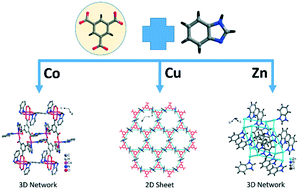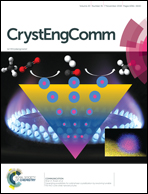Hybrid materials based on transition metal–BTC–benzimidazole: solvent assisted crystallographic and structural switching†
Abstract
Five transition metal–BTC–BIm based coordination polymers, namely [Zn2(HBTC)2(BIm)2(H2O)2]·(H2O)3, 1; [2-HABI]2[Zn2(BTC)2(2-ABI)(H2O)]·(H2O)5, 2; [Cu3(BTC)2(BIm)6][solvent], 3; [Co4(BTC)3(BIm)6][solvent], 4; and [(CH3CH2)2NH2][Zn(BTC)(BIm)]·(H2O), 5 have been synthesized and characterized using complementary techniques like single crystal X-ray analysis, powder X-ray diffraction (PXRD) and thermogravimetric analysis (TGA) (BTC = 1,3,5-benzene tricarboxylic acid, BIm = benzimidazole and 2-ABI = 2-aminobenzimidazole). Crystal structure analysis of these compounds showed that 1 forms a 1D chain, 2 and 3 have 2D layers while 4 and 5 have three-dimensional architectures. 3 forms a hexagonal bronze sheet, 4 has a three-dimensional network with embedded paddlewheel SBUs and helical assembly, and 5 crystallizes in a polar space group (Pna21) with 3D helical networks with adamantane-type topology. The dielectric properties of 5 showed that the dielectric constant rapidly decreases with an increase in frequency suggesting dipole relaxation at low frequencies.



 Please wait while we load your content...
Please wait while we load your content...